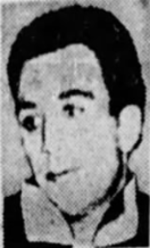 Star Tribune (Minneapolis, Minnesota), February 14, 1967 Sentenced to death in 1956 in Hancock County, Illinois, for the murder of 8-year-old Janice Elizabeth May the previous year, Miller was exonerated and released after eleven years on the basis that his conviction had rested on perjured testimony and significant misrepresentation of physical evidence. On November 26, 1955, Janice May’s body was found in an abandoned rail car near her house in the town of Canton. Two days later, a 29-year-old cabdriver, Lloyd Eldon Miller Jr., was arrested for the crime. He was tried, convicted, and sentenced to death. The conviction rested primarily on a confession that prosecutors persuaded the trial judge had been voluntarily signed. Although Miller denied his guilt, he claimed that he had signed the confession only because police threatened him with the death penalty if he refused to sign it. A second important factor in indicting Miller was the written statement by Betty Baldwin, a waitress who had met him about five weeks before and who became a ‘special’ friend of his. She claimed that she had had a conversation with Miller in which he allegedly admitted he was responsible for Janice May’s death. From the moment a police officer put thumb cuffs on Miller, his long journey had begun. For almost three days (from November 28 to December 1) he had to endure extensive hours of interrogation. First, he was taken to the Sangamon County jail where he was interrogated by the Fulton County Sheriff, by one deputy sheriff, and by a number of authorities from Vermillion County. Then two polygraph operators, J. Lynch and D. Whitlock, transported him to the Illinois Bureau of Criminal Identification and Investigation in the State armory in Springfield. One lie detector test after another, followed by endless questioning, all of which were accompanied by threats, promises, cajolery, and violence, led Miller to finally sign the confession. However, the confession was written by one of those officials. Miller did not read it, nor was it read to him, before he signed it. Moreover, during the trial, Miller’s version of the interrogation period was completely different from the police officers’ versions, which also differed from one another. Even though the trial court did not focus on how much the officials’ versions varied from one another (about the dates, times, places, and people interrogating Miller), this would later support the argument that these official testimonies were filled with lies. The trial court in Hancock County convicted Miller in November 1956 and sentenced him to death. Until the end of 1963, Miller’s attorneys battled in the state and federal courts to save him but were never able to prove that he was wrongfully convicted. Ten execution dates were set. On four occasions the Supreme Court of the United States denied review. Nonetheless, in 1963, significant facts were unearthed that undermined the conviction. A primary piece of evidence used to find Miller guilty of Janice May’s murder was a pair of shorts which the prosecution contended were bloodstained and had been discarded by Miller after the murder. A chemist for the Illinois crime laboratory had testified at Miller’s trial in 1956 that the shorts had type A blood on them, the same type as that of the victim. However, at a habeas corpus hearing in federal District court in 1963, a microanalyst testified that the reddish-brown strains on the shorts were not blood but paint. It was determined that the counsel for the prosecution had not only known at the time of the trial that the shorts were stained with paint but had also faked the most crucial physical evidence in Miller’s case. Miller’s landlady and her daughter also confirmed that Miller was at home napping at the time of crime. Subsequently, Betty Baldwin admitted as well that she had lied in her witness testimony for the trial court. In February 1967, the U.S. Supreme Court overturned Miller’s conviction, stating that “the prosecution deliberately misrepresented the truth.” Miller was released from prison shortly thereafter in March 1967. The charges against Miller were dismissed by a federal court in September 1971. – Researched by Ayse Tuker
|